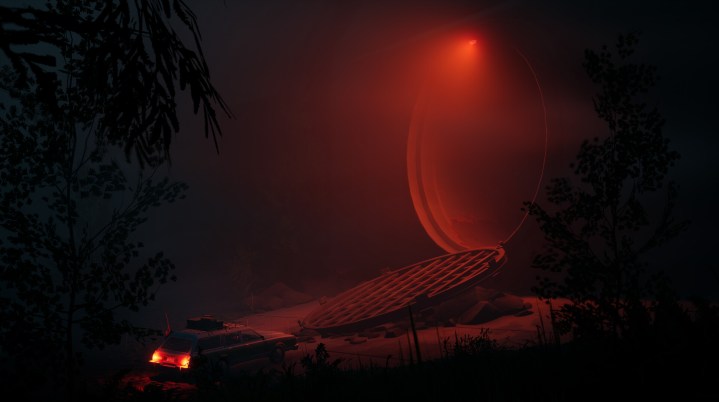
If 2023 taught me anything, it’s that I’m hungry for alt-horror games. I was captivated by both Dredge and Slay the Princess last year, a duo of eerie games with a fresh approach to the genre. Dredge was more of a slow burn descent into madness housed within a fishing simulator, while Slay the Princess brings gore and body horror to a philosophical visual novel. As much as I loved playing traditional horror games like Amnesia: The Bunker, I found myself wanting to ride down the roads less traveled in the genre.
Pacific Drive couldn’t be coming at a better time. Set to launch on February 22, the upcoming title might be exactly what I’m craving. It’s an entirely unique premise: players set out on a supernatural road trip across the Pacific Northwest in a beat-up station wagon. Despite having followed its development closely, I didn’t really know what to expect from it tonally. Now that I’ve played a few hours of it, I do: It’s damn creepy.
While it’s not an outright horror game, Pacific Drive‘s early hours deliver an unsettling atmosphere that had me jumping out of my seat quite a few times. I’m less sure if I’m sold on its repetitive looting or complicated crafting, but it’s making a strong enough first impression that I’m willing to ride with it for the long haul.
Road trip
My road trip begins unassumingly enough. I’m dropped into my trusty car as I drive around a winding road on a gray day. I quickly learn that handling my vehicle isn’t as simple as holding the right trigger. I need to turn the key myself to fire it up, throw the stick shift into drive, toggle the headlight on when I hit a tunnel, and control the windshield wipers when I go through a patch of rain. It isn’t long until I learn that I need to pay attention to detail. When I make a quick stop to pop into an abandoned store early on, I exit to discover my car halfway down the road. I’d forgot to put it back in park.
That’s where Pacific Drive immediately stands out; I’m building a real relationship with my car. I need to learn all its eccentricities if I’m going to keep it in one piece — and I mean that literally. I soon make my way to a garage, where I learn the core juggling act at the heart of the adventure. Every piece of my car, from headlights to panels, can deteriorate. I need to fix them up with putty, craft replacement parts, and top off my fuel tank before heading out on any drive to make sure I’m ready for the road ahead. That’s a strong loop, as fixing up my car has the same satisfaction as cleaning a home in House Flipper 2.

What’s less exciting about that hook is how much it turns the core game into a resource-looting grind. Whenever I go out on a drive, I find that I’m spending a lot of time walking into empty houses and emptying out lockers full of metal and plastic. A scrapper tool lets me destroy any object and reduce it to parts, while a gravity hammer allows me to smash generators and grab the plasma within. Most of my playtime would be spent driving down a road, stopping to grab more junk, and crafting objects. Tools like crowbars make that more engaging, ensuring I always had the right tools to break into a locked building, but I can see where the loop could get repetitive.
What grabs me more during my demo, though, are the supernatural scares I’d experience on my journey. Pacific Drive has me going out on short “runs” through the Olympic Exclusion Zone, home to a host of otherworldly occurrences. The world’s atmosphere most closely mirrors that of Control, with objects levitating around me or eerie geometric shapes lining the roads. The early missions introduce a simple goal I need to complete in each stretch of my trip: harvest energy-filled orbs to create an exit back to the garage, where I can tune up. That would be easy enough … if the world itself wasn’t trying to kill me.
My first jump scare would come when I grabbed an orb and walked it back to my car. Everything was quiet, so it seemed like I was in the clear. That was, until a section of road jutted out underneath me, sending both me and the ball flying. I’d seen a lot of creepy images up to the point, from menacing drones to still mannequins sitting in the road, but it’s this moment that freaked me out more than anything. I can’t trust that anything in the Exclusion Zone is safe.

The locked first-person perspective used while I’m driving helps that. At first, I’m annoyed that I can’t zoom out to a third-person view of my car. I quickly realize that Pacific Drive wouldn’t have the same impact in that perspective; my limited view makes the world that much more freighting. At one point, I drive over some yellow gashes in the road, not knowing what they are. I’m completely caught off guard as I’m shot into the air, helplessly watching the world outside speed by my window. It’s a disorienting moment that leaves me wondering what the hell is happening to me (it turns out those yellow gashes are geysers with enough force to send my car flying). I find plenty of scares like that in my first runs as I try to get a grip on an unpredictable world through my narrow viewpoint.
Pacific Drive is one of those games that I don’t think I’ll really have a grasp on until I play it all in context. The early hours throw a lot of systems out and require some repetitive grinding. As neat as its supernatural element is, I’m left wondering if it’s the kind of game where I simply watch spooky things happen from a distance while carrying out comparatively dull gameplay tasks. I’m sure I haven’t seen the full picture yet, but that’s what excites me about the final game. I have no idea where this road leads; I have to trust the wheel.
Pacific Drive launches on February 22 for PlayStation 5 and PC.



